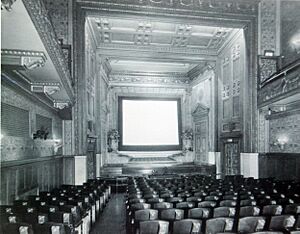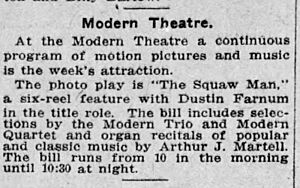Modern Theatre (Boston) facts for kids

(1915)
|
|
| Address | 525 Washington Street, Boston, MA 02111 |
|---|---|
| Coordinates | 42°21′15″N 71°03′44″W / 42.35417°N 71.06211°W |
| Owner | Suffolk University |
| Type | Theatre |
| Capacity | 185 |
| Construction | |
| Opened | 1876 |
| Renovated | 1914, 2010 |
| Architect | Levi Newcomb (original) Clarence H. Blackall (conversion) Childs Bertman Tseckares (renovation) |
The Modern Theatre is a cool place in downtown Boston, Massachusetts. It's on Washington Street. This theater first opened in 1914. It used to be a different kind of building. A famous architect named Clarence H. Blackall changed it into a movie theater.
In 2009, Suffolk University took down the old building. They carefully saved its front part, called the facade. Then, they built a brand new theater on the same spot. Suffolk's new Modern Theatre opened on November 4, 2010.
The theater is part of the Washington Street Theatre District. This area became a special historic place in 1979. The city of Boston also named the Modern Theatre a Boston Landmark in 2002.
Contents
History of the Modern Theatre
The story of the Modern Theatre began in 1876. A Boston architect named Levi Newcomb designed a large building. It was a warehouse and showroom for John and James Dobson. They owned the biggest carpet factories in the United States.
The building had five floors. It was made of Ohio sandstone. The ground floor had cool cast-iron storefronts. The Dobson company moved into this new building in early 1878.
Becoming a Movie Theater
In 1913, a Boston businessman named George White had an idea. He hired Clarence H. Blackall to turn the building into a theater. Movies, or "photo-plays," were becoming very popular then.
Blackall's plan changed the basement and first two floors. The first floor had a small entrance area. There was a round ticket booth and a lobby. This led to a long, narrow room for the audience. It also had a balcony. About 800 people could watch movies there.
The theater had a small stage and a dressing room. There was also a pit for an orchestra. This pit held a special Estey organ. It had many pipes and keys.
A professor from Harvard University, Wallace C. Sabine, helped with the sound. He was a pioneer in architectural acoustics, which is about how sound works in buildings. The inside of the theater looked fancy. It had Italian marble and dark wood. Blackall also added a new, classic-looking front made of white marble.
The Modern Theatre was one of the first to have air conditioning! A newspaper reported how it worked. They dug a deep well, almost 600 feet down. This gave them lots of cold water. This water was used to cool and clean the air. In winter, the air was heated. In summer, the air was cooled to a comfy 70 degrees.
Early Days of Movies
The Modern Theatre opened on June 25, 1914. It was likely the first theater in Boston made just for movies. Jacob Lourie, a theater owner, ran it. They showed silent films, had singers, and organ concerts.
In 1927, Lourie added new sound equipment called Vitaphone. This allowed them to show movies with sound. One of the first was Don Juan. The next year, they showed The Jazz Singer. This was a very important movie. It was the first long movie with both music and people talking.
Changes Over Time
In 1949, the theater changed its name to the Mayflower Theatre. By the 1970s, it started showing different kinds of films. The Mayflower closed in 1976 and became run down.
In 1977, a young actor named David L. Archer wanted to fix it up. He planned to use it for community performances. On December 12, 1978, the theater reopened. It was called the Modern Theater again. It hosted many events, including jazz artists like Cecil Taylor and Herbie Mann. It also had mime shows and plays. But this new effort didn't last long. The Modern Theater closed again in May 1981. It had hosted over 200 events.
A New Beginning
After closing, the theater changed owners a few times. But no one fixed it up. Then, in 2007, Suffolk University bought the building. They wanted to build more housing for their students.
In 2009, the university carefully removed the front part of the building. Then, they took the rest of the building down. A company called CBT Architects designed a new, modern theater. It also had a ten-story student residence hall above it. The saved original front was put back onto the new building.
Suffolk's new Modern Theatre opened on November 4, 2010. It's a multi-purpose space. It can seat 185 people.
The National Trust for Historic Preservation gave the Modern Theatre an award in 2011. This award was for helping to make the Washington Street area better.
Gallery
-
An advertisement for the Modern and Beacon Theatre from 1920







